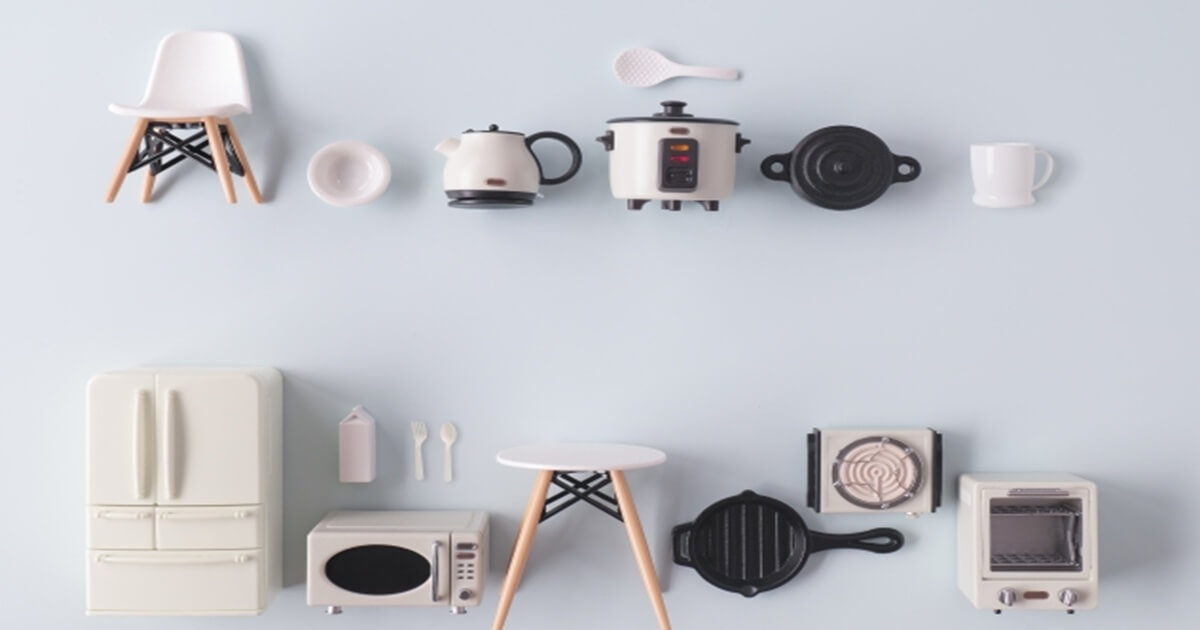In this section, I’d like to introduce some essential kitchen tools and appliances that every beginner cook should consider—ranging from affordable 100-yen shop items to useful kitchen electronics.
I’ll also talk about whether it’s okay to start out with inexpensive tools from the 100-yen store if you’re on a budget!
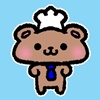 Ponkuma
PonkumaI’m highlighting items I personally use and love, as well as those with great reviews!
kitchen appliances
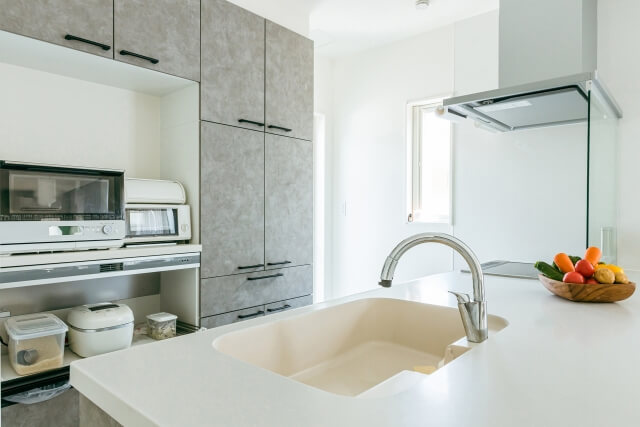

※Images are for illustration only.
(If only I had a kitchen this beautiful…)
Refrigerator
For those living alone, a 200–300L fridge is a good size.
For families of 3–4 people, aim for something 400L or larger.
A bigger fridge is super convenient—you can stock up when groceries are on sale and store lots of meal prep. It really makes life easier!
(We recently upgraded our fridge and I’ve been feeling the difference every day!)
After visiting several electronics stores, I found that Hitachi refrigerators came highly recommended. I ended up scoring a discounted model and I love it!
This is the one we use at home:
Spacious and highly
\recommended!/
For those living solo, this one is a popular option on Amazon▼
Simple and budget-friendly
\Available in different colors too/
Microwave / Oven Microwave
Instead of a basic microwave, we opted for an oven microwave.



What’s the difference between a microwave and an oven microwave?



A microwave just heats things up.
An oven microwave can heat and bake!
If you’re cooking for a family, something 25L or larger will make a big difference.
We use an older model at home:
\Very user-friendly—highly recommended!/
For solo living and simple reheating, check this one out▼
\2025 Bestseller!/
Rice Cooker
- For solo living: 3-cup (go) capacity is ideal
- For families: 5.5-cup or more is better
Cook in bulk and freeze in portions to save money!
This is the one we use:
\Makes amazingly fluffy rice with special steam technology♪/
Here’s a great option for solo households▼
Gas Stove
If you’re planning to cook regularly, a 2-burner stove is super convenient for preparing multiple dishes at once.
Be cautious with cassette-type stoves—they often lack safety features and can be dangerous for everyday use.
Especially for beginners, I strongly recommend a stove with proper safety features to protect yourself.



Make sure to check if your stove is compatible with city gas or propane before buying!
If you’re unsure, it’s best to consult your gas company—even if it costs a bit more, safety first!
Toaster
If you enjoy eating toast, having a toaster can be really convenient.
For those who cook regularly, it’s also handy for adding a nice golden finish to dishes.
If your microwave already has a toast function, you might not need a separate toaster—so check your appliance first.▼
\Looking for a great toaster? Check this one out!/
For solo living, here’s a simple and popular toaster on Amazon:
\This one’s a bestseller!/
Electric Kettle
Electric Kettle
An electric kettle is incredibly useful!
- For solo living: ~1L is enough
- For families: go for 1.5L or more
After a long day, it’s so tempting to doze off while waiting for water to boil on the stove… (I’ve had some close calls myself )
That’s why I’d say an electric kettle is a must-have for anyone living alone!
Essential Kitchen Items for Beginners


Let’s go over some of the basic kitchen tools every beginner should have.
Knife
A stainless steel knife with a blade length of about 15–20 cm is easy to handle for beginners.
If you can, having an extra knife just for cutting fruits or foods eaten raw is also convenient♪



If you live alone, even a simple knife from the 100-yen shop is fine to start with!
If you’re looking for a more decent-quality knife:
\Here’s a recommended option/
Want to see more knife recommendations? Check out the article below▼
Cutting Board
I’ve tried many types, but I’ve found that plastic cutting boards are the easiest to clean.
Also, bigger boards are definitely easier to work with!
It’s also helpful to have two boards: one main cutting board, and one smaller one from the 100-yen shop for quick tasks.



I use the smaller board for cutting fruits or ingredients I eat raw♪
\This is the bestselling cutting board on Amazon/
\This is the one I personally use!/
Frying Pan
I’ve used various types, but I think nonstick (fluorine-coated) frying pans are easiest for beginners.



What size is best?



For 1 person: 22 cm
For 2 people: 24 cm
For 2–3 people: 26 cm
For 4 people: 28 cm
If you’re living alone and have limited kitchen space, a deep frying pan is a great choice.
Why? Because it’s versatile—it can be used for stir-frying, simmering, deep-frying, even making sauces.
When buying, make sure the pan is compatible with your stove: gas or IH (induction heating).
Also, it’s important to choose products from trusted brands that use safe materials.
\This is the one we use at home/



If you have enough storage space, having multiple pans in different sizes can be very useful♪
Want to browse more frying pans?▼
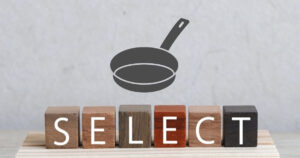

Pot (Saucepan)



What size pot do I need?



Whether you live alone or with family, a 16 cm and 20 cm pot set is essential.
If you’re cooking for 3–4 people, a 24 cm pot is also very useful.
I’ve tried many kinds of pots, and I really recommend ones with removable handles—they’re great for storage.
(Of course, if you have plenty of storage space, any kind is fine!)
If you’re looking for quality and space-saving, the T-fal set is a solid choice. Durable coating, oven-safe, and great for small kitchens.
ちなみに『16・20の鍋・とって』計3点を単品で購入すると8000円ほどしてしまいます…やっぱりセット購入がダンゼンお得みたいです。
Recommended set for families (3–4 people)▼
\Buying as a set is way more affordable♪/
This set includes:
- 16 & 20 cm pots with lids
- 26 cm deep frying pan
- 26 cm shallow frying pan
If you’re living alone, this set is perfect▼
\Includes ideal frying pan sizes too!/
Contents:
- 16 & 20 cm pots with lids
- 22 cm and 26 cm frying pans
Lid
If your frying pan doesn’t come with a lid, getting one universal lid that fits multiple sizes is super useful!
Mixing Bowl & Strainer
To start, you can get a matching set from the 100-yen shop.
However, plastic ones often can’t withstand high heat (usually around 100°C), so be careful when pouring boiling water.
If you plan to use them in the microwave, go for heat-resistant glass.
Kitchen Scissors
Super handy and can double as a knife in many cases.
Even one from the 100-yen shop is fine for starters!
\Look for ones that come apart for easier cleaning—it’s more hygienic!/
\Here’s what I’m using for the shoot./
ピーラー(皮むき)
For beginners, a ceramic peeler from a 100-yen shop is safer and less likely to cause injury.
Can be used not only to peel vegetables but also to remove potato eyes or slice veggies.
\Here’s what I’m using for the shoot./
Wooden Spatula
While 100-yen versions are available, some have surface coatings that may not be ideal.
If possible, check that it’s made of natural wood, or buy from a trusted brand for safety.
Ladle
If you’re using a nonstick pot, choose a silicone ladle to avoid scratching the coating.
Turner (Spatula for flipping food)
Same goes for turners—if you’re using a nonstick pan, a silicone turner is a must to protect the surface.
100-yen options are okay, but make sure it’s heat-resistant and preferably from a trusted brand.
Measuring Spoons
You only need one set: tablespoon and teaspoon.
100-yen versions work fine.
Measuring Cup
A 200 ml (cc) measuring cup is all you need.
Again, 100-yen shops have plenty of options.
Cooking Chopsticks
Chopsticks from 100-yen shops are okay, but go for natural materials like bamboo, cherry, or chestnut.
If you want better quality, I recommend heat-resistant silicone chopsticks from trusted brands
Rice Paddle (Shamoji)
Get one that can stand on its own and has a textured surface to prevent rice from sticking.
Available at 100-yen shops too.
Whisk
A simple manual whisk is good to have on hand.
100-yen options are fine, though if you don’t plan to bake, you may not need one at all.
Mixing Bowl
A deep bowl is more hygienic because it prevents ingredients from splashing out♪
Digital Kitchen Scale
A scale that can measure up to 2 kg is especially convenient♪
Rubber Spatula
Often very handy—this tool is a must-have if you want to try baking. Having two spatulas can be even more useful.
Avoid budget versions from dollar stores. Opt for heat-resistant rubber spatulas made by trusted brands.
Whisk (for Cream)(クリーム用)
Having one whisk specifically for whipping cream is really helpful.
Electric Hand Mixer
Having an electric mixer definitely makes baking so much easier!
Silpat / Silicone Baking Mat
A high-performance silicone mat for use in the oven. It works from about –40 °C up to around 250–300 °C.
I use mine again and again for cookies, bread, and even caramel apples. It’s incredibly handy!
Silpat mats are praised by professionals and home bakers for being durable,
Dough Scraper
Essential for bread making.
Cake pan
Piping bag
Piping tips
Palette knife
Cookie cutters
Bottle and Can Opener
Many cans nowadays don’t need an opener, but keeping a basic one at home can come in handy just in case.
Kettle
A 1L kettle is quite practical. You can also use a pot instead, but if you plan to boil water for tea often, it’s a good idea to have it. If you already own an electric kettle, you might not need a separate kettle.
Tableware & Cutlery
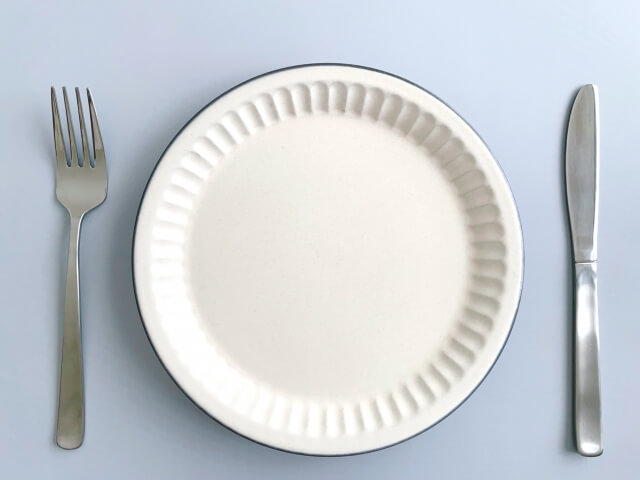






我が家はニトリ製品を愛用♪
シンプルなものが使いやすくておススメ♪
Rice bowl
simple ones from dollar stores are fine.
Cup / Mug
Useful for coffee or soup, especially for solo living. Dollar-store items are okay.
Large deep bowls
Having two deep bowls for soups like ramen or udon can be very convenient.
Chopsticks
Basic ones are fine, but those in the dishwasher should be heat-resistant. Japanese-made chopsticks are recommended.
Plates
20–25 cm diameter is ideal for serving mains and side dishes.
Spoons and forks
Dollar-store items are okay; simple styles are easiest to clean.
Kitchen Consumables
Plastic wrap
Essential in every kitchen! We usually buy it from wholesale supermarkets.
Aluminum foil
Useful for oven baking, making drop-in lids, and more! A Japan-made brand is a favorite in my household.
Thick freezer bags
Very handy for freezing food.
Plastic zipper bags
Multipurpose (freezer, fridge, microwave-safe up to about 120 °C).
Permanent marker
For labeling freezer bags or foil with food names and dates to avoid over-freeezing.
Paper towels
Always useful in the kitchen.
Parchment paper (cooking sheets)
helpful if you plan to bake cookies or bread.
Extra but Convenient Tools
Kitchen timer
Handy for people who tend to forget cooking times.
Bamboo sushi mat (Makisu)
Mini mortar & pestle
Cotton swabs
Fish bone tweezers
Bonus Item (Pro-level Tool)
Used by professionals and famous hotels—this slicer is incredibly sharp and cuts brilliantly!
Summary
When starting cooking, first gather the essential tools and supplies.
This will help you begin in a comfortable, enjoyable way.
I hope this article inspires you to start cooking.
Thank you for reading to the end!


